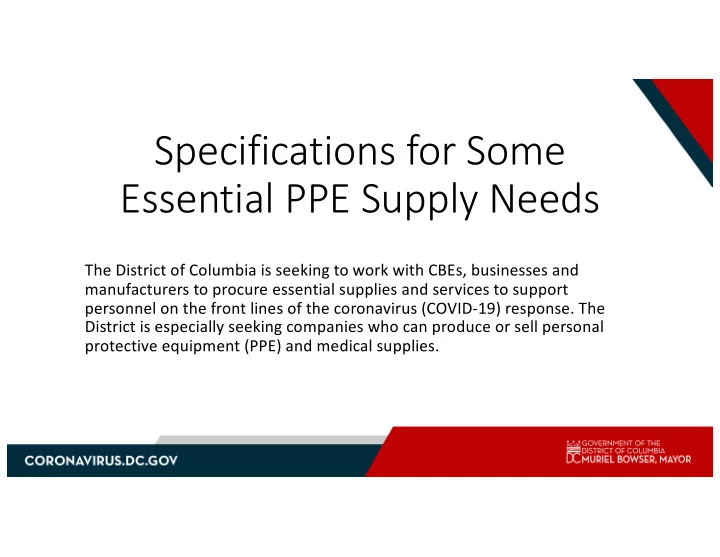

Specifications for Some Essential PPE Supply Needs The District of Columbia is seeking to work with CBEs, businesses and manufacturers to procure essential supplies and services to support personnel on the front lines of the coronavirus (COVID-19) response. The District is especially seeking companies who can produce or sell personal protective equipment (PPE) and medical supplies.
Level 3 & 4 Isolation Gowns Isolation Gowns (Level 3 and 4) Single use level 3 & Level 4 isolation meeting standard of either • o NFPA 1999 garments o ASTM F1671 (pass) and high levels of tensile strength (≥ 50 N), tear resistance (≥17N), and seam strength (≥ 50N) using the methods in NFPA 1999 OR • Universal-size, plastic-film impervious gown with perforated back with thumb holes, adjustable cuff, or other garment retention that ensures its stability NFPA 1999- Standard applies the performance, testing, design, and certification of new emergency medical garments; emergency medical examination gloves: emergency medical helmets; emergency medical face protection devices; emergency medical footwear and footwear covers; medical care facility footwear; and single-use and multiple-use, emergency protective ensembles
Level 3 & 4 Isolation Gowns (cont’d) Level Criteria for Usage Appropriate Environmental Usage • 1 Used for MINIMAL risk situations Basic care, standard hospital medical unit • Provides a slight barrier to small amounts of fluid penetration • Single test of water impacting the surface of the gown material is conducted to assess protection performance 2 • Used in LOW risk situations Blood draw from a vein, suturing, intensive care • Provides a barrier to larger amounts of fluids penetration through splatter and unit, pathology lab some fluid exposure through soaking • Two tests are conducted to assess barrier protection performance: • Water impacting the surface of the gown material • Pressurizing the material 3 • Used in MODERATE risk situations Arterial blood draw, Inserting an IV, Emergency • Provides a barrier to larger amounts of fluid penetration through splatter and Room Trauma fluid exposure through soaking than Level 2 • Two tests are conducted to test barrier protection performance: • Water impacting the surface of the gown material DC seeks • Pressurizing the material Level 3 and Level 4 • 4 Used in HIGH risk situations Pathogen resistance. Infectious disease (non- Gowns and • Prevents all fluid penetration for up to 1 hour airborne), Large amounts of fluid exposure over • Coverings May prevent VIRUS penetration for up to 1 hour long periods • In addition to the other tests conducted under levels 1-3 barrier level performance is tested with a simulated blood containing a virus. If no virus is found at the end of the test, the gown passes
Nitrile Gloves Gloves (Nitrile) Single-use examination gloves meeting standard of either: • o NFPA 1999 o ASTM D6319 Minimum of 5 mil thickness • Extended cuff (to ensure overlap with garment sleeve) • Sizes desired: (XS, 1% Small 27%,Medium 45%,Large 26%, XL 1%) • No vinyl gloves • NFPA 1999- Standard applies the performance, testing, design, and certification of new emergency medical garments; emergency medical examination gloves: emergency medical helmets; emergency medical face protection devices; emergency medical footwear and footwear covers; medical care facility footwear; and single-use and multiple-use, emergency protective ensembles
Face and Eye Protection Face Shields • Clear, durable and impervious face shields. The majority of eye and face protection currently used in the U.S. is designed, tested, and manufactured in accordance with the American National Standards Institute (ANSI)/International Safety Equipment Association (ISEA) Z.87.1–2010 standard. From the infection control standpoint, no standards currently exist regarding performance standards (International Safety Equipment Association (ISEA) : “Draft ISEA 119: Standard for eye and Face Protection against Biological Hazards.” Available at https://safetyequipment.org/userfiles/File/Background_statement.pdf )
N95 Masks N95 Masks CDC/NOISH approved N95 masks in the following types and • allotments: o 1860 (65%) o 1860S (15%) o 8210 (10%) o 9210 (10%)
Level 2 or 3 Medical Masks Medical Masks (Level 2 or Level 3) Single-use medical masks rated ASTM F2100 Level 2 (or Level 3) or equivalent : • o Fluid resistance at 120 mm Hg (Level 3 fluid resistance at 160 mm Hg) o Bacterial Filtration Efficiency at BFE ≥ 98% o Particulate Filtration Efficiency at PFE ≥ 98% at 0.1 micron o Breathability at < 5.0 mm H20 o Flame Spread at Class 1
Non-Medical Face Coverings Non-Medical Face Coverings • Disposable 3-ply masks OR reusable, washable fabric masks.
Recommend
More recommend